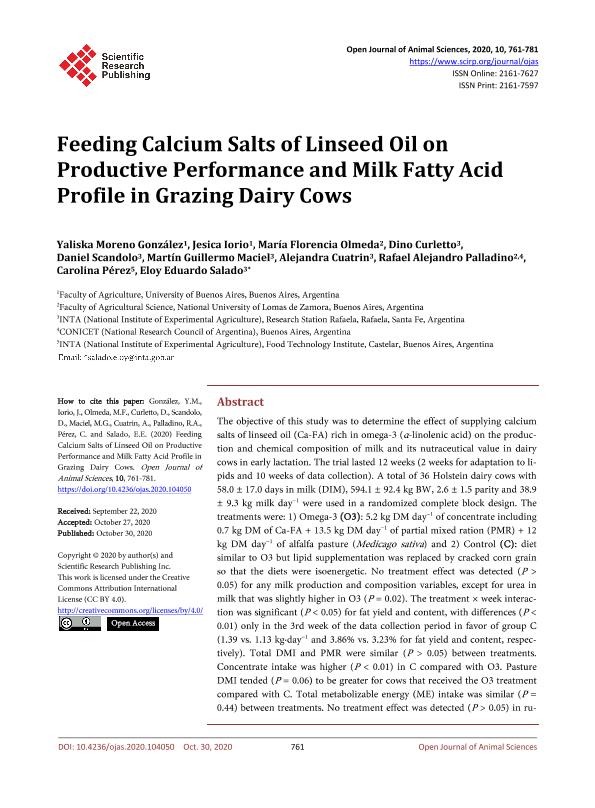Artículo
Feeding Calcium Salts of Linseed Oil on Productive Performance and Milk Fatty Acid Profile in Grazing Dairy Cows
Gonzalez Moreno, Yaliska; Iorio, Jesica Daniela; Olmeda, María Florencia; Curletto, Dino; Scandolo, Daniel; Maciel, Martín Guillermo; Quatrin, Alejandra; Palladino, Rafael Alejandro ; Perez, Carolina; Salado, Eloy Eduardo
; Perez, Carolina; Salado, Eloy Eduardo
 ; Perez, Carolina; Salado, Eloy Eduardo
; Perez, Carolina; Salado, Eloy Eduardo
Fecha de publicación:
10/2020
Editorial:
Scientific Research Publishing
Revista:
Open Journal of Animal Sciences
ISSN:
2161-7597
e-ISSN:
2161-7627
Idioma:
Inglés
Tipo de recurso:
Artículo publicado
Clasificación temática:
Resumen
The objective of this study was to determine the effect of supplying calcium salts of linseed oil (Ca-FA) rich in omega-3 (α-linolenic acid) on the production and chemical composition of milk and its nutraceutical value in dairy cows in early lactation. The trial lasted 12 weeks (2 weeks for adaptation to lipids and 10 weeks of data collection). A total of 36 Holstein dairy cows with 58.0 ± 17.0 days in milk (DIM), 594.1 ± 92.4 kg BW, 2.6 ± 1.5 parity and 38.9 ± 9.3 kg milk day-1 were used in a randomized complete block design. The treatments were: 1) Omega-3 (O3): 5.2 kg DM day-1 of concentrate including 0.7 kg DM of Ca-FA + 13.5 kg DM day-1 of partial mixed ration (PMR) + 12 kg DM day-1 of alfalfa pasture (Medicago sativa) and 2) Control (C): diet similar to O3 but lipid supplementation was replaced by cracked corn grain so that the diets were isoenergetic. No treatment effect was detected (P > 0.05) for any milk production and composition variables, except for urea in milk that was slightly higher in O3 (P = 0.02). The treatment × week interaction was significant (P < 0.05) for fat yield and content, with differences (P < 0.01) only in the 3rd week of the data collection period in favor of group C (1.39 vs. 1.13 kg·day-1 and 3.86% vs. 3.23% for fat yield and content, respectively). Total DMI and PMR were similar (P > 0.05) between treatments. Concentrate intake was higher (P < 0.01) in C compared with O3. Pasture DMI tended (P = 0.06) to be greater for cows that received the O3 treatment compared with C. Total metabolizable energy (ME) intake was similar (P = 0.44) between treatments. No treatment effect was detected (P > 0.05) in rumen environment parameters. Supplementation with Ca-FA reduced (P < 0.05) the hypercholesterolemic fraction of milk (C12:0, C14:0 and C16:0, -13.6%, -7.4% and -9.0%, respectively). The concentration of α-linolenic acid (C18:3n-3) increased (108%, P < 0.01) in O3 group compared with group C. The absence of negative effects of lipids on the fat content of milk and ruminal fermentation suggests that protection by saponification was effective. The supplementation with Ca-FA (0.85 kg·day-1) improved the healthy value of the milk.
Archivos asociados
Licencia
Identificadores
Colecciones
Articulos(SEDE CENTRAL)
Articulos de SEDE CENTRAL
Articulos de SEDE CENTRAL
Citación
Gonzalez Moreno, Yaliska; Iorio, Jesica Daniela; Olmeda, María Florencia; Curletto, Dino; Scandolo, Daniel; et al.; Feeding Calcium Salts of Linseed Oil on Productive Performance and Milk Fatty Acid Profile in Grazing Dairy Cows; Scientific Research Publishing; Open Journal of Animal Sciences; 10; 4; 10-2020; 761-781
Compartir
Altmétricas



